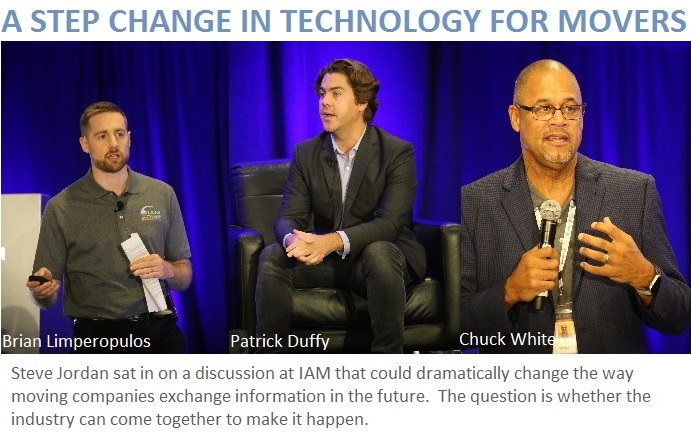Steve Jordan sat in on a discussion at IAM that could dramatically change the way moving companies exchange information in the future. The question is whether the industry can come together to make it happen.

On 3 October, 2019, IAM (International Association of Movers) hosted an invitation-only meeting to discuss the future of communications within the industry. It was billed as the Global Moving & Mobility Standards Summit, but it was about much more than just Standards: it heralded the possibility of a communications revolution in the industry that will require a level of trust and cooperation beyond what has been seen to date. The potential prize, however, would be a step change in efficiency, leading the way towards significant economies and improvements in service for the entire industry.
Chuck White, President of IAM, opened the discussion. He explained that it is essential that the whole industry finds a way to work together to build a platform on which to work with each other seamlessly, even across disparate IT systems. He urged everyone to keep an open mind and said the first part of the process would be to develop standard ways of communicating. “The future is bright if we can engage with each other,” he said.
There were around 75 attendees including members of IT companies, relocation management companies, movers, customers and the US government. In his introduction, Brian Limperopulos, IAM Vice President said that the organisation had already made a significant start with the introduction of the ISO 17451 Standards for the codification and electronic transfer of inventories. What was now needed was to get the whole industry working towards those Standards and to empower key individuals to drive the programme forwards.
Brian introduced a panel of experts to prime the discussion. Patrick Duffy, President of the Blockchain in Transportation Alliance (BiTA) of which IAM is a member; Sloane Brakeville, CEO of Fr8 Network, that was already working on the subject for the freight industry; and Ray daSilva, President of Mobility Exchange, IAM’s technology partner.
Once developed, common Standards would allow the transfer of information through a central hub, perhaps based on blockchain technology. Patrick gave a brief overview of blockchain. He said it would allow all the systems within the moving process to talk to each other without duplication of effort or information. Sloane likened the movement of information to the development of the ISO container for moving physical goods which allowed everyone to invest in the necessary infrastructure. In the same way, a new protocol would describe how digital information moves around from one organisation to another. Ray brought it to the customer level saying that even though the industry was very fragmented we needed to develop a common language that would transform customer requirements into operational instructions that everyone’s system could understand. Having Standard systems will be a fundamental first step to achieving this.
“Technology is not the barrier,” Ray said. “Our biggest challenge lies with the people in this room being able to put down the fear of losing competitive advantage and shift towards looking at the benefits of collaboration. What can we do together if we put our guard down? There is an urgency because our industry is in trouble. Every opportunity to eke out extra margin will help us. The competitive pressure to do it for less, to do it better and to do it faster is not going away. Our only defence is if we come together as an industry. There’s still plenty of room for companies to differentiate themselves.”
If this were possible there would be significant cost savings. It won’t be easy, but it seems clear that it will be necessary for a neutral, not-for-profit organisation to make it happen. Chuck White believes that it should be IAM and other industry associations that come together to drive it. It should be viewed as a utility, just like roads paid for by taxes.
Although the benefits were appreciated by the group, there were some concerns. Charles Olden of the US State Department was concerned about all this information going into one place and providing a track of individuals’ movements. Ray daSilva, however, pointed out that a central system would be much more secure than the current system of transferring information by e-mail.
The meeting lasted for two hours. Opinions were voiced, ideas exchanged and IAM committed to pushing this initiative forward and developing a coalition of key players to be its driving force. The technology exists to make this a reality. The cost, when spread across the entire industry, is not likely to be prohibitive. What is in doubt is the industry’s resolve to make it happen by shaking off commercial concerns and focussing on the bigger picture. It is clear, however, that if the moving industry does not seize the initiative it is likely to fall back as other players do so. Perhaps this time, unlike so many industry advances in the past, movers will take a lead.